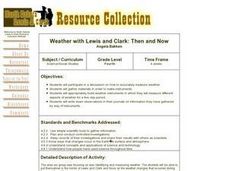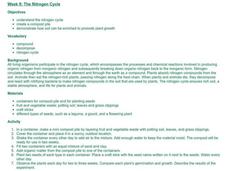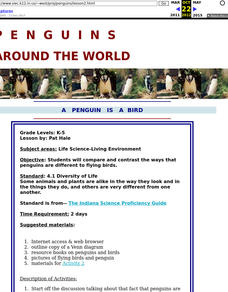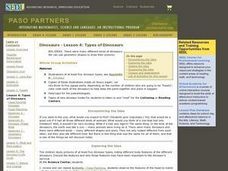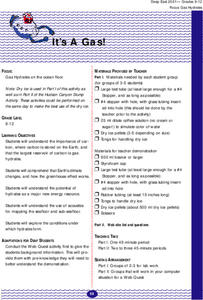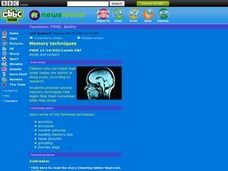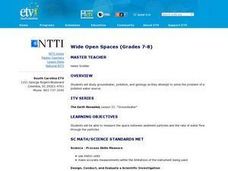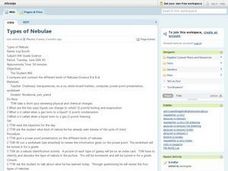Curated OER
The Ultimate Predator
Students listen to a lecture by the teacher about the "Ultimate Predator." They design a new "Ultimate Predator." Students present their creations to the class and attempt to convince their classmates that their predator is indeed the...
Curated OER
Martha Who?
Students explore how the number and types of organisms an ecosystem can support depends on the resources available and on abiotic factors, such as quantities of light and water, a range of temperatures, soil composition. They are...
Curated OER
Changing Weather: Comparing Climate from Voyageur Times to Today
Fifth graders compare climates. In this weather lesson, 5th graders observe and record weather observations and discuss the impact of weather on people. Students also discuss the concept of global warming and determine how weather...
Curated OER
Fronts
Fourth graders define cold and warm fronts, explain how they are formed and they ways that they affect the weather.
Curated OER
Weather with Lewis and Clark: Then and Now
Fourth graders observe and write descriptions of the weather in a journal for one week. They research the daily journals of Lewis and Clark, compare the weather words used to their own personal journals, and discuss the need to...
Curated OER
The Nitrogen Cycle
Students design and create a compost pile in order to study the Nitrogen Cycle. They then use the scientific method to determine if plants grow better when they add organic matter from their compost pile to the plant's soil.
Curated OER
Cold Fronts And Warm Fronts
Students simulate the movement of cold and warm fronts as they listen to a story about the weather and Mr. Sun. They brainstorm the characteristics of each type of front then write about which front they would prefer if they were a...
Curated OER
The Force of Gravity
Third graders observe and analyze the forces of gravity. They are going to pretend to go on a bike ride and listen carefully as you describe the terrain. Students respond appropriately to the forces of gravity. They throw the ball into...
Curated OER
Energy Flow - How Much Biomass do Plants Produce?
Students explore the concept of biomass. In this plant lesson, students conduct a scientific investigation that requires them to observe plant growth and biomass.
Curated OER
Ancient Sun Models of the World
Students explain that many different cultures across the world developed their own reasoning for the weather around them. They explore the different cultural beliefs of the sun's cycle and to create their own story of the sun's movement.
Curated OER
Disposable vs. Reusable, Biodegradable vs. Non-biodegradable
Students examine and identify biodegradable and non-biodegradable materials. They discover ways in which biodegradable materials can help minimize pollution.
Curated OER
Chemical and Physical Changes
Eighth graders investigate different gas behaviors. In this chemistry lesson, 8th graders describe how changing volume and temperature affect gas particles motion. They collect data and make a generalization about these variables'...
Curated OER
A Penguin is a Bird
Students compare and contrast the ways that penguins are different to flying birds.
Curated OER
How Do You Define Spring?
Students conduct surveys to determine when spring occurs in the minds of people in their area. They organize and interpret their data.
Curated OER
Types of Dinosaurs
Students complete puzzles of dinosaurs. They compare each piece of the puzzle to a fossil and simulate a scientist's role in learning about dinosaurs.
Curated OER
Rock Creek Water Quality
Ninth graders test water in a local creek using chemical kits and probes. They take GPS readings and digital photos. They calculate the Water Quality Index and create a spreadsheet of the test data.
Curated OER
It's a Gas!
Students explore the conditions under which hydrates form. They use the Internet to access information and conduct experiments to examine how the greenhouse effect works.
Curated OER
The Water Cycle - Family Page
Learners discuss the steps of the water cycle. They create their own model of the water cycle. They complete the Family Page at the end of the lesson.
Curated OER
What Can I Do About Global Environmental Change?
Students complete a unit to evaluate their impact on the environment and greenhouse gas emissions. They conduct Internet research, develop a list of their electrical and energy use, calculate their share of greenhouse gases, and identify...
Curated OER
Memory Techniques
Students enhance memorization skills by using the following techniques: acrostics, acronyms, number pictures, spelling memory tips, name pictures, grouping, and journey pegs.
Curated OER
USING YEAST AS AN ULTRAVIOLET LIGHT MEASUREMENT TOOL
Pupils realize the importance of organisms as standards of measurement and experimentation.The first lab is a simple survival curve that demonstrates the effects of UV light on cells. The second lab looks at repair mechanisms of the DNA...
Curated OER
Wide Open Spaces
Learners examine the problem of groundwater pollution. In groups, they develop a solution to solve the problem of a local polluted water source. They also practice measuring the space between sediment particles and the rate of water flow.
Curated OER
Types Of Nebulae
Eighth graders explore the different types of nebulae that can be found in the solar system. They view a PowerPoint presentation about the material and identify each nebulae as it is presented. Students also discuss the life cycle of a...
Curated OER
Our Eye in the Sky: The TIROS Weather Satellite
Students investigate the political context of the creation of a weather satellite. In this technology and society lesson, students explore the historical, technological, and political context of the TIROS weather satellite. They write a...






